
Encyclopedia Brown is a series of books featuring the adventures of boy detective Leroy Brown, nicknamed "Encyclopedia" for his intelligence and range of knowledge. The series of 29 children's novels was written by Donald J. Sobol, with the first book published in 1963 and the last published posthumously in 2012. In addition to the main books, the Encyclopedia Brown series has spawned a comic strip, a TV series, and compilation books of puzzles and games.
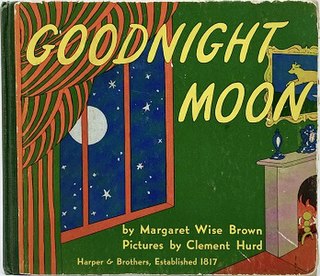
Goodnight Moon is an American children's book written by Margaret Wise Brown and illustrated by Clement Hurd. It was published on 3 September 1947, and is a highly acclaimed bedtime story.
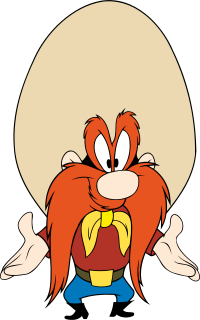
Yosemite Sam is a cartoon character in the Looney Tunes and Merrie Melodies series of short films produced by Warner Bros. His name is taken from Yosemite National Park. He is an adversary of Bugs Bunny. He is commonly depicted as an extremely aggressive, gunslinging outlaw, pirate, or cowboy with a hair-trigger temper and an intense hatred of rabbits, Bugs in particular. In cartoons with non-Western themes, he uses various aliases, including "Chilkoot Sam" and "Square-deal Sam" in 14 Carrot Rabbit, "Riff Raff Sam" in Sahara Hare, "Sam Schultz" in Big House Bunny, "Seagoin' Sam" in Buccaneer Bunny, "Shanghai Sam" in Mutiny on the Bunny, "Von Schamm the Hessian" in Bunker Hill Bunny, "Baron Sam von Schpamm" in Dumb Patrol, and many others. During the golden age of American animation, Yosemite Sam appeared in 33 shorts made between 1945 and 1964.

Margaret Wise Brown was an American writer of children's books, including Goodnight Moon and The Runaway Bunny, both illustrated by Clement Hurd. She has been called "the laureate of the nursery" for her achievements.
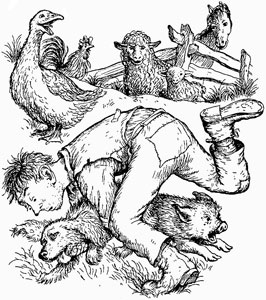
Garth Montgomery Williams was an American artist who came to prominence in the American postwar era as an illustrator of children's books. Many of the books he illustrated have become classics of American children's literature.
In Stuart Little, Charlotte's Web, and in the Little House series of books of Laura Ingalls Wilder, Williams['s] drawings have become inseparable from how we think of those stories. In that respect ... Williams['s] work belongs in the same class as Sir John Tenniel's drawings for Alice in Wonderland, or Ernest Shepard's illustrations for Winnie the Pooh.

All This and Rabbit Stew is a 1941 Merrie Melodies cartoon directed by Tex Avery. The cartoon was released on September 13, 1941, and features Bugs Bunny.

Clement Gazzam Hurd was an American artist. He is known for illustrations of children's picture books, especially collaborations with writer Margaret Wise Brown including Goodnight Moon (1947) and The Runaway Bunny (1942).
John Thacher Hurd is an American artist and the creator of children's picture books including Mama Don't Allow and Art Dog.

Rabbit's Kin is a 1952 Warner Bros. Merrie Melodies animated short directed by Robert McKimson and written by Tedd Pierce. The cartoon was released on November 15, 1952, and stars Bugs Bunny. The cartoon was animated by Charles McKimson, Herman Cohen, Rod Scribner, Phil DeLara and Keith Darling. The music was scored by Carl Stalling while the layouts and backgrounds were done by Robert Givens and Richard H. Thomas, respectively.

A Hare Grows In Manhattan is a Warner Bros. cartoon in the Merrie Melodies series, released on March 22, 1947. It was produced by Edward Selzer and directed by I. Freleng. The short features Bugs Bunny.
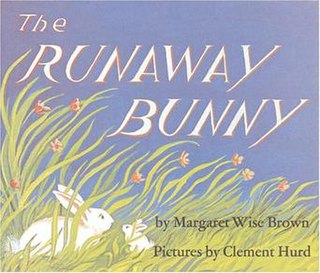
The Runaway Bunny is a 1942 picture book written by Margaret Wise Brown and illustrated by Clement Hurd. The plot deals with a small rabbit, who wants to run away. His mother, however, tells him that "if you run away, I will run after you."

Lillian Hoban was an American illustrator and children's writer best known for picture books created with her husband Russell Hoban. According to OCLC, she has published 326 works in 1,401 publications in 11 languages.
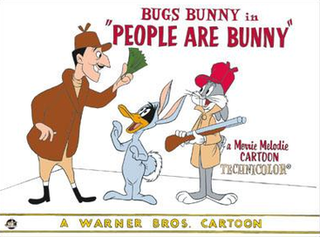
People Are Bunny is a 1959 Warner Bros. Merrie Melodies cartoon, directed by Robert McKimson The short was released on December 19, 1959, and stars Bugs Bunny and Daffy Duck.
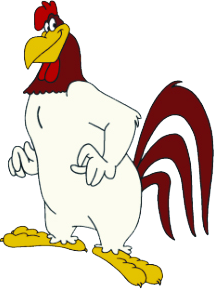
Foghorn Leghorn is a cartoon rooster who appears in Looney Tunes and Merrie Melodies cartoons and films from Warner Bros. Animation. He was created by Robert McKimson, and starred in 29 cartoons from 1946 to 1964 in the golden age of American animation. All 29 of these cartoons were directed by McKimson.

Elmer J. Fudd is an animated cartoon character in the Warner Bros. Looney Tunes/Merrie Melodies series and the archenemy of Bugs Bunny. He has one of the more disputed origins in the Warner Bros. cartoon pantheon. His aim is to hunt Bugs, but he usually ends up seriously injuring himself and other antagonizing characters. He speaks in an unusual way, replacing his Rs and Ls with Ws, so he often refers to Bugs Bunny as a "scwewy" or "wascawwy (rascally) wabbit". Elmer's signature catchphrase is, "Shhh. Be vewy vewy quiet, I'm hunting wabbits", as well as his trademark laughter.
The character that would evolve into Bugs Bunny appeared in four cartoon shorts before his first official appearance in Tex Avery's A Wild Hare. While this early version is commonly referred to as "Happy Rabbit", animation historian David Gerstein disputes this, saying that the only usage of the term was from Mel Blanc himself; the name "Bugs Bunny" was used as early as April 1938, from a model sheet made by Charles Thorson which was used for the short Hare-um Scare-um. Bugs was also mentioned by name from an August 1939 review of the short in the Motion Picture Herald.
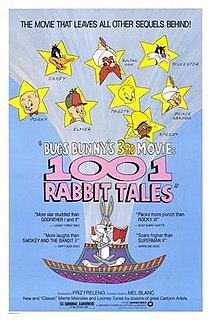
Bugs Bunny's 3rd Movie: 1001 Rabbit Tales is a 1982 animated anthology comedy film directed by Friz Freleng with a compilation of Warner Bros. cartoon shorts and animated bridging sequences, hosted by Bugs Bunny.

My World is an American children's picture book written by Margaret Wise Brown and illustrated by Clement Hurd. The third book in Brown and Hurd's "classic series", it is the "companion" to Brown & Hurd's Goodnight Moon. My World was published in December 1949.
W. R. Scott was a children's literature publisher based in New York City that specialized in visually striking books with a contemporary educational philosophy. W. R. Scott's first editor was Margaret Wise Brown; the company also published a number of her books.
















